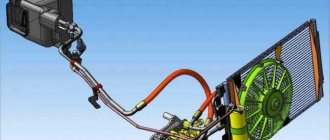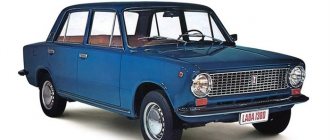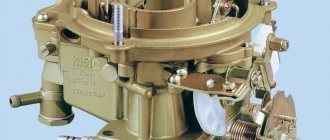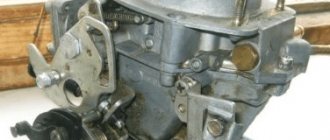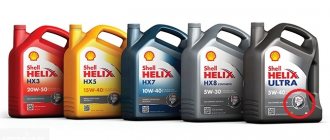In 1990, the production of the well-known “99” - VAZ 21099 - began. Now, it does not lose its popularity among buyers. The fuel consumption of the VAZ 21099 per 100 km is of interest to almost every future owner - it is about 11 liters
. Driving a car, engine type, and road surface directly affect fuel consumption. In addition, there is a strong dependence on the year of manufacture; the newer the car, the more economical it is and uses less fuel. Next, we’ll talk more precisely about how to reduce the gasoline consumption of a VAZ 21099 and what can be modified for the desired savings.
VAZ 21099 in detail about fuel consumption
In 1990, the production of the well-known “99” - VAZ 21099 - began. Now, it does not lose its popularity among buyers. The fuel consumption of the VAZ 21099 per 100 km is of interest to almost every future owner - it is about 11 liters
. Driving a car, engine type, and road surface directly affect fuel consumption. In addition, there is a strong dependence on the year of manufacture; the newer the car, the more economical it is and uses less fuel. Next, we’ll talk more precisely about how to reduce the gasoline consumption of a VAZ 21099 and what can be modified for the desired savings.
What determines the cost of a VAZ?
A front-wheel drive sedan is considered a Russian car, which is intended for traveling on Russian highways. Lada models from 2000 to 2007 have an engine capacity of 1.5 liters. Based on driver reviews, we can conclude that the car feels better in the city than off-road.
| Engine | Consumption (highway) | Consumption (city) | Consumption (mixed cycle) |
| 1.1 | — | 7.9 l/100 km | — |
| 1.3 67 hp | — | 7 l/100 km | — |
| 1.5 | 5.7 l/100 km | 8 l/100 km | 7.7 l/100 km |
| 1.6 | 5.7 l/100 km | 9.1 l/100 km | 7.7 l/100 km |
| 1.3 140 hp | 7 l/100 km | 12.5 l/100 km | 10 l/100 km |
Fuel consumption for the VAZ 21099 (carburetor) depends on:
- year of manufacture of the car;
- on the cleanliness of the filters;
- filled with good quality oil;
- on engine volume;
- on the condition of the injectors;
- depending on the type of ride;
- maneuverability;
- from technical characteristics.
Every experienced driver knows that the filter must be changed frequently to function properly.
Getting around the city
The type of driving and all maneuvers around the city result in high fuel consumption. After all, the engine does not work smoothly, often changes speeds, switches, and because of this, LADA gasoline consumption per 100 km exceeds 12 liters.
VAZ 21099 1.5 MT 70hp
The presented configuration is one of the most common versions of the VAZ 21099. This particular engine can be considered the base one. If we talk about the body or interior, then this modification does not have any remarkable elements. The unit runs on gasoline only and is paired with a manual transmission. The drive is exclusively front-wheel drive. In terms of consumption, the figures are quite social: city – 9.1 liters, highway – 5.5 liters. Maximum acceleration is up to 155 km per hour. The unit reaches the 100 km per hour mark in 14 seconds.
- Alexey, Dnepropetrovsk. 99th 2001 1.5 MT 70 horsepower. A real workhorse, albeit with shortcomings. I consider the main disadvantage to be unreliability and frequent breakdowns. But I don’t leave a lot of money at the gas station (I eat about 9 liters in the city at 60 km/h). In short, Sergey, Nizhny Tagil. I traveled outside the region more than once with my 1.5-liter version of 2002. On the highway I always accelerate to 130-140 km/h. It runs smoothly, but you have to turn it up to 3500 rpm to shift normally. This style takes almost 7.5 liters on a smooth highway.
- Anton, Petrovsk. One and a half liters for 70 horses is the most economical unit. It’s just that the year 2003 is already taking its toll. Everything falls apart, including the engine. I’ve already made a capital investment, but I don’t want to change it. It's too economical. In the city 9 liters without exaggeration.
- Andrey, Magnitogorsk. 21099 1.5 MT (70 horses). The main thing is not to jerk or accelerate unnecessarily. Calm style up to 90 km/h. Driving like this allows me to get under 9.2 liters in the city. Although if you get stuck in a traffic jam and turn on the heater so that the engine doesn’t heat up, it will probably go over 10.
- Vladimir, Pervouralsk. For a long time I worked part-time at 99th. If it were a fresh year (I have a 2001 model year and a 1.5 70 horsepower), then I couldn’t think of a better car for a taxi. I go out onto the track, put it in fifth gear, and accelerate to 120 km per hour. It turns out quickly and inexpensively, almost 6 liters of gasoline per hundred square meters. The main thing is not to go too fast and not drive more than 140 km/h. Otherwise it will start eating right away.
What reasons influence high fuel consumption?
Already experienced drivers can tell exactly why their car, for one reason or another, has high gas mileage. We would like to give you an example of several problems that the owner of a VAZ 21099 car may encounter:
- poor or incomplete opening of the carburetor damper;
- lack of oil in the gearbox - leads to a reduction in transmission;
- the ignition timing is poorly set - early or late ignition reduces power;
- the vacuum accumulator sensor is faulty;
- when a large amount of fuel enters the carburetor.
Such nuances should be taken into account if you decide to find the problem of high fuel use.
Setting the ignition timing
When the ignition timing is correctly set, all indicators of engine performance (reactivity, power, idling, energy consumption) are within normal limits. To carry out the work, you must have a strobe and a tachometer, an open-end or socket wrench of 10. In general terms, the setup is done as follows:
- The engine warms up to operating temperature. Low idle speeds are set by ear or on the tachometer (less than 800 rpm), after which the engine is turned off.
- On the gearbox housing, look for a hatch with a visible part of the flywheel and a scale. Most often it is closed with a rubber stopper that needs to be removed.
The advance angle is adjusted by rotating the distributor (ignition distributor housing). Clockwise - the advance angle increases (early ignition), counterclockwise - decreases (late ignition). When the desired angle is set, the engine is turned off, the strobe light is turned off, and the distributor is secured.
How to reduce gasoline consumption in a VAZ
VAZ 21099 is a rather rare modification of this car brand, created for import to other countries. All its embedded data indicates average fuel consumption, power, speed, convenience and practicality. In terms of fuel consumption VAZ 21099, the injector also has advantages over its predecessors. To reduce fuel consumption on a VAZ, you need to do the following:
- clean the fuel filter;
- check for fuel leaks;
- adjust the carburetor;
- configure lambda umbrella;
- warm up the engine to operating temperature so that the fuel does not just flow out, but warms up and is consumed.
The owner of a VAZ 21099 already knows in practice what still needs to be done to reduce gasoline consumption.
Fuel consumption outside the city
VAZ 21099 with a 1.5 liter engine and 135 horsepower is quite practical for driving outside the city, through fields. But do not neglect its practicality and go on dirt roads in the rain and slush. On such a road, a VAZ may require about 10 liters per 100 km.
Therefore, after filling the tank, you need to calculate the distance, as well as the necessary additional consumption. When off-road, try to drive at one speed, do not switch from one to the next, and then back - this will lead to an increase in the amount of gasoline used.
Real gasoline consumption of VAZ 21099
The famous ninety-ninth model is still very popular among domestic car enthusiasts. This is a practical sedan that replaced the no less popular “nine”, which was produced in a hatchback body. Among the advantages of the car, car enthusiasts note:
- body capacity;
- reliability of all units;
- maintainability;
- cheap spare parts;
- optimization for domestic roads and climate.
One of the reasons for the popularity of the car is economical fuel consumption for all versions of the VAZ 21099. The car was produced from 1990 to 2004 at the main facilities of the plant, after that for another 8 years at one of the Ukrainian plants.
Consumption of VAZ 21099 with carburetor
Initially, the car was equipped with several modifications of gasoline engines of various designs and volumes. The most affordable was the 1.3 engine with 64 horsepower. It, like other versions of the car, was equipped with a five-speed manual transmission with front-wheel drive. The car accelerated to hundreds in 14.5 seconds with a top speed of 140 km/h. With a carburetor fuel supply system, the fuel consumption of this engine was:
- city 9.1 l;
- average 7.7 l;
- on the highway 5.7 liters.
A rotary version of the engine of the same volume with 135 horsepower was offered, but it was supplied to special services and for export. The installation of this power unit improved the dynamics, but at the same time fuel consumption increased:
- in city mode 12.5 l:
- in a mixed cycle 10 l;
- on a free road 7 l.
The most popular was the 1.5 engine with 70 horsepower; it was distinguished by its reliability, accelerating the car to 150 km/h, and to the first hundred in 14 seconds. It is fueled with AI 92 or AI 95 with fuel consumption similar to the less powerful version:
- in traffic 9.1 l;
- on average 7.7 l;
- on the highway 5.5 l.
Owner reviews
- Vladimir, Petrozavodsk. On occasion, I purchased a VAZ 21099 car with a 1.3 rotary engine with 135 horsepower. The power is felt, the car starts briskly at traffic lights, and feels good on the highway when overtaking. But the motor is capricious; you often have to adjust the carburetor. Consumption data in the city is 13 liters per hundred square meters, on the highway it turns out to be about 8 liters.
- Sergey, Kharkov. I have a Lada 21099 with a 1.3 engine with 64 horsepower. A very reliable car, passable, suitable for our rough roads. The power is not enough, but I don’t race, and that’s enough for me. But you can drive around the city or to the country without any problems. Average consumption is 7-9 liters, depending on the time of year and the quality of the road.
- Alexey, Krasnodar. Since 2004, there has been a carburetor VAZ 21099 with a 1.5 engine of 70 horsepower. I consider it the best option for our realities. Repairs cost pennies, the chassis copes well with the loads, I made an overhaul in 2014, and since then I have only changed the oil and filter. Consumption from 6 liters on the highway to 10 in city mode.
VAZ 21099 1.3 MT 135hp
This is a rather rare version of the compact sedan. The main purpose of creating this modification is import. It was precisely this “charged” engine, as conceived by the designers, that should have appealed to the foreign public. The release of the 135-horsepower engine took place in the same year, 1990, as the debut of the car itself. With such a modest engine size and a non-standard amount of horsepower for Russia of that era, consumption was quite moderate: city - 12.5 liters, highway - 7 liters. Maximum speed is up to 190 km per hour. It is recommended to use AI95 for this installation.
Real gas consumption
- Makar, Yelabuga. I have the so-called sport version with 1.3 liters and 135 horses (1995 onwards). It has enough power, but the carburetor periodically fails. There is no stability at idle, which is why the consumption is about 13 liters in the city. I always try to turn it off when I stop.
- Sergey, Perm. Luxury 99th 1.3 2001. The engine is not bad, but not for this body and the design as a whole. It accelerates quickly, and the consumption on the highway is low (7.5-8 liters). But it doesn’t hold the road well, it shakes and you have to constantly steer.
- Dmitry, Kaliningrad. I don’t understand how I managed to take a VAZ 21099 when domestic cars are very rare in our city. I came across a 1.3 MT with 135 horsepower. I only fill up with 95 gasoline and try not to vomit too much. But the consumption is still cosmic (city - 13.5 liters). It's like a rocket, it eats a lot and flies fast.
- Alexander, Dolgoprudny. At traffic lights I go head to head with the Focus and Nissan Maxima. Of course, my “basin” has a 1.3-liter 135-horsepower monster. The official data almost doesn’t lie, I shoot 10 seconds before hundred. Well, the consumption is quite affordable (city - 12 liters, highway - 10). At least on the standard 1.5-liter version, fuel consumption is 2 liters less.
- Nikolay, Moscow. I drove a 1.3 MT 1999 for three years. The engine is strong, but it’s immediately clear that it’s domestic. When accelerating to 140 km/h, consumption exceeds 12 liters without thinking. And there is noise in the cabin, and it seems that the engine is about to jump out.
Consumption of VAZ 21099 with an injector
Injectors began to be installed on the VAZ 21099 in 2000. Direct fuel injection made it possible to increase the power of power units, while reducing their fuel consumption. The most popular injection modification of the car comes with a 1.5 engine. The designers increased the power to 78 hp, acceleration to hundreds is 13.5 seconds with a maximum speed of 155 kilometers per hour with fuel consumption:
- in traffic 8.8 l;
- on average 7.4 l;
- on a country road 5.4 liters.
VAZ 2109 1.1 53 hp
Niva fuel consumption.
table with fuel consumption in the field. acceptable fuel consumption for the field “ Fuel consumption rate per 100 km
This is the weakest version in the entire line of engines. The start of sales of this modification (VAZ 21091) took place in 1987. But this particular installation was not widely used and was discontinued in 1997. The hatchback itself has front-wheel drive and only a manual transmission. The power supply system is a carburetor. The only plus in this variation is consumption: in the city - 8.2 liters, and on the highway - 5.4 liters. Maximum acceleration is up to 139 km per hour. Acceleration to hundreds is carried out in 17 seconds.
Fuel consumption on Russian roads
- Pavel, Gorodets. It is difficult to measure consumption on a 1991 “nine” with a 1.1 liter engine. Not a hint of the on-board computer. I understand that I came across a real exotic, but for a novice student driver this is the only available option for now. I won’t say that a glass of gasoline is enough for her, but the approximate consumption is within 8-9 liters in the city.
- Sergey, Vyborg. I was able to withstand only one year on the 1.1-liter version of the “nine” produced in 1992. Well, the car doesn’t pull along the highway at all. It feels like it was made for grandfathers who can handle 40 km/h. By the way, the consumption of the VAZ 21091 is no less than that of the same model with a one and a half liter engine. On average 9 liters per 100 km in the combined cycle.
- Artem, Elista. For a summer resident, like I am, the main thing is to deliver garden tools and all rubbish safe and sound. So my nine is 1.1 liter. I don't regret 1989. It can withstand speeds of 100 km/h. Moreover, 20 liters is enough for two full trips (a total of 370 km).
- Alexander, St. Petersburg. My VAZ 21091 1.1l. 1992 - the car is clearly not for the track and long trips. The engine strains a lot when you try to reach a cruising speed of 120 km/h. In the city, the differences with the 1.5 version are almost imperceptible, both in terms of consumption (8.5-9.0 liters) and dynamics. That is, if you move 60 km/h, then there are no complaints about such a motor.
- Sergey, Ufa. Some kind of defective 1.1 liter version. I got my hands on a 1993 Nine with just such an engine. Neither accelerate normally nor move off. I thought maybe the consumption would be minimal. I was mistaken, it consumes the same engine as a regular model with a basic 1.5-liter engine (city - 8 liters per 100 km, highway - 6 liters).
How to reduce fuel consumption
Despite the efficiency of the VAZ 21099, there are often reviews of increased gasoline consumption. The most popular reason is the subjective factor. Driving too dynamically increases consumption by up to 50%. It is recommended to move off smoothly, change gears in time in the range of 2-3 thousand revolutions, and move on the highway at a speed of 90-100 mph. There are other problems that, by eliminating them, can reduce fuel consumption on the VAZ 21099:
- Engine wear. If the compression in the cylinders drops below 8.5 atmospheres, a major overhaul is necessary; after running in, the engine's appetite will decrease.
- Pressure in the slopes. The manufacturer recommends 2 atmospheres. A decrease in pressure is especially harmful; the car begins to “float” on the road, and consumption increases.
- Open windows at high speeds increase consumption by 1.5 liters, the turned on air conditioner takes 1 liter per hundred, so it is better to use it on long trips.
- There is no need to overload the car with tools and other items.
- Periodically adjust the carburetor and clean the injector; they become clogged, the quality of the mixture is impaired, which leads to overspending. If you don't pay attention to this, the car will simply break down.
Fuel consumption VAZ 21099
The driver is the most dangerous component of the car
VAZ 21099 is probably the most popular sedan in our country. Production of the car began in 1990 and successfully continued until 2004, and in Ukraine even until 2011. The model differed from other cars in its family in body kits, dashboard, and interior trim. Later, all this began to be used in new Lada models.
Restyling
Most Russians prefer domestic cars to foreign cars, and most of the models were produced a long time ago.
Among modern cars - VAZ-2109. But the vehicle is both technically and morally outdated. Restyling will help give the car a second life.
Many people are interested in where to start. All Russian cars, regardless of the year of manufacture, have a common problem - the level of sound insulation.
This does not apply to those who like to drive slowly, but there are vehicles that accelerate to 90 km/h and above; you have to shout so that the passengers sitting behind can hear the driver.
Dashboard. The next level is advanced car restyling. In this case, the most dramatic changes to the car are coming.
Official data (l/100 km)
| Engine | Consumption (city) | Consumption (highway) | Flow (mixed) |
| 1.3 MT 64 hp (Mechanics) | 9.1 | 5.7 | 7.7 |
| 1.3 MT 135 hp (Mechanics) | 12.5 | 7.0 | 10.0 |
| 1.5 MT 70 hp (Mechanics) | 9.1 | 5.7 | 7.7 |
| 1.5 MT 78 hp (Mechanics) | 8.8 | 5.4 | 7.4 |
| 1.6 MT 81 hp (Mechanics) | 9.1 | 5.7 | 7.7 |
VAZ 21099 was equipped only with gasoline engines. The smallest is 1.3 liters. Its power was 64 horsepower. The carburetor was responsible for supplying fuel. The engine is four-cylinder, each with two valves. There was also a version with a rotary engine with 135 horsepower. A carburetor was also installed on it. Fuel consumption per 100 km varied from 7.6 liters with a conventional power unit to 10.1 liters with a rotary one.
The second engine is 1.5 liters. Its power depended on the fuel supply system. If it was carried out using a carburetor, then the engine produced 70 hp, and if it was an injector, then 78 horsepower. Gasoline consumption was registered at 7.6 liters. And the last engine is 1.6 liters. Its peak power was 81 horsepower, and fuel was delivered only through an injector. This configuration consumed up to 7.6 liters of gasoline. Like all our cars of that time, only a manual transmission was installed on the model, which operated in five modes.
Fuel consumption Lada 21099 1990, sedan, 1st generation
| Engine capacity | Power | Transmission | Drive unit | Fuel | Consumption |
| 1.5 l | 78 hp | Manual transmission | front-wheel drive | Gasoline AI-95 | 7,4 |
| 1.6 l | 81 hp | Manual transmission | front-wheel drive | Gasoline AI-95 | 7,7 |
| 1.5 l | 72 hp | Manual transmission | front-wheel drive | Gasoline AI-92 | 7,7 |
| 1.5 l | 70 hp | Manual transmission | front-wheel drive | Gasoline AI-92 | 7,7 |
| 1.3 l | 64 hp | Manual transmission | front-wheel drive | Gasoline AI-92 | 7,7 |
| 1.1 l | 54 hp | Manual transmission | front-wheel drive | Gasoline AI-92 | 7,9 |
| 1.3 l | 140 hp | Manual transmission | front-wheel drive | Gasoline AI-95 | 10,0 |
Owner reviews
“I have the most powerful ninety-nine with a rotary engine. I got it from my father, who bought himself a foreign car, and gave this car to me so that I could gain experience in driving and repairs. What can I say about the car. It looks quite tolerable, and my father took care of the car, so there is not even the slightest damage. The interior is poorly equipped, but all the necessary functions are available, so the ride is quite comfortable. There is a lot of space, enough for the whole family to travel, and even to throw things in. Well, the most important thing is the engine. It pulls very vigorously, and you can even reach decent speeds on the highway. Its only drawback is its high gasoline consumption, which reaches 15 liters in the city, and 8 on the highway,” Evgeniy from St. Petersburg left this review about the car.
“I passed my license and immediately started thinking about a car. I didn’t have a lot of money, and the requests for a future car did not suit every model. I couldn't find anything better than 21099, so I bought it. A good sedan that performs well on the highway, in the city, and on small off-road terrain. I often go on nature trips with friends, so the car is full of people and things. But this is not a hindrance for the ninety-ninth; it copes with its tasks perfectly. I try to actively monitor her condition so as not to kill her prematurely. Although this is very difficult to do. As for the consumption, it’s almost like the passport one, the difference is about a liter,” said Konstantin from Petrozavodsk about the car.
“I’ve always been for our cars, because I don’t need anything more. I love sedans, so I was choosing between several models, but settled on 21099. Its rectangular design evoked the most pleasant emotions in me. The interior is assembled with high quality, the materials are poor, but it doesn’t matter to me, the main thing is that it doesn’t fall apart. There is a lot of space, especially in the trunk. This is important to me, since I often carry out various transportations. Technical data at a high level. The car drives equally well both in the city and on the highway. I want to test it by going somewhere far into nature. Many people write that it shows excellent cross-country ability there too, but I want to make sure for myself. The only thing that annoys me is the high fuel consumption. I live in cold places, so in winter there are absolutely crazy numbers - up to 18 liters,” this review was written by Dmitry from Yakutsk.
“I bought this car immediately after receiving my license. I really regretted this decision after a year of use. Serious problems began with the chassis, in which I had already invested a lot of money. I drove for a couple of months and something broke in the engine. Again I took it to repairs and again paid a lot of money. Later, problems began with the body, although I always looked after the car, did not leave it dirty, and treated it with various preparations. I think I will sell it, since I no longer have the strength to buy it. Now she seems to be driving, but a new problem has appeared - consumption has increased. If earlier I spent no more than 10 liters, now my norm is 14. I was thinking about upgrading the firmware, since it is much cheaper than paying for extra liters of gasoline, especially since I still drive often,” these are the words about the car from Vladimir from Krasnodar.
“My grandfather gave me the car when he could no longer drive it himself. The condition was close to ideal, but this was not enough for me, and I decided to improve the car in various ways. This is not my main car, so I could afford such actions. I invested a lot of money into it over the course of a year. Probably, it was possible to buy a new good foreign car. But it wouldn't compare to what I have now. New sports body kits made in the best tuning studio in the country, a rebuilt interior, a reassembled dashboard, an extended body, thanks to which there is more space in the back row, doors that open upwards. Well, the most important thing is the engine. This is where most of the money is invested. But its power is now comparable to various BMWs and Mercedes. The most surprising thing is that its consumption has become less than it was in stock. Now I spend about 8 liters in the city,” these were the words the car received from Gennady from Moscow.
“At first I was not happy about this car, because they gave it to me without knowing whether I wanted it or not. But, since this is my first personal vehicle, I did not resist and slowly began to study the car. As it turned out, everything is not so bad. Yes, it’s not very attractive in appearance, and the interior is poorly decorated and not stuffed with various functions, but it’s not a shame to kill it, although I can’t imagine how this can be done. The body looks like it's made of armor. And various technical parts are assembled with high quality, nothing breaks. My motor is not the most powerful, but it is quite enough for a quiet ride around the city. I don’t plan to race, so I’m quite happy with everything. My consumption usually does not exceed 9 liters,” writes Valery from Kazan.
High fuel consumption of VAZ 2108, 2109, 21099, 2105, 2107 cars
Let's consider the reasons for the high fuel consumption on VAZ 2108, 21081, 21083, 2109, 21093, 21099, 2105, 2107 cars and similar ones with carburetors 2108, 21081, 21083 Solex 2105, 2107 Ozone.
In this article we list those that are directly related to one or another carburetor malfunction. Other reasons not related to it are set out in the article “Causes of increased fuel consumption not related to the carburetor.” The page “Fuel consumption of VAZ cars with carburetor engines” provides examples of fuel consumption for various models of VAZ cars. Compare whether your consumption fits into the given standards. Perhaps the seemingly high fuel consumption actually falls within the standards set by the factory. If it doesn’t fit, then here is a list of possible reasons for this behavior of your car.
Reasons for high fuel consumption on VAZ 2108, 2109, 21099, 2105, 2107, etc.
Carburetor choke is not fully open
When a warm car engine is running, the air damper in the carburetor must be completely open and positioned strictly vertically. In this case, the “choke” handle must be recessed all the way. This applies to both carburetors 2105, 2107 “Ozone” and carburetors 2108 “Solex”.
fully open air dampers of carburetors 2108, 21081, 21083 Solex, 2105, 2107 Ozone
If the air damper is not fully open, with the choke handle fully recessed, then there is a malfunction. In this case, the volume of air entering the fuel mixture decreases, and the proportion of gasoline increases. The fuel mixture enters the engine cylinders over-enriched, and fuel consumption increases.
the air dampers of carburetors 2108, 21081, 21083 Solex and 2105, 2107 Ozone are not fully open due to their drive being incorrectly adjusted
Sometimes some car owners, having a worn-out engine in their car, try to revive its former throttle response, deliberately set the carburetor choke to some extent, thus forcibly enriching the fuel mixture and slightly resuscitating the engine’s former capabilities. But again, this is fraught with an increase in fuel consumption significantly. The same trick can be done when the engine is running poorly at idle or even completely absent. If this problem is detected, adjust the air damper actuator:
Idle air fuel nozzle holder or solenoid valve is loose
The fuel mixture, in this case, enters the idle system, bypassing the idle fuel jet (inserted into the jet holder or into the solenoid valve - depending on the carburetor model), since it turns out to be loosely pressed to its seat. As a result, a large volume of additional fuel enters the cylinders not only at idle, but also in all operating modes of the car engine. The more you press the gas pedal, the more the vacuum in the carburetor chambers increases and the more excess fuel is sucked into the engine cylinders through the idle system.
carburetor solenoid valves 2108, 21081, 21083 Solex, 2105, 2107 Ozone
In such a situation, on carburetors with a holder (plug), you should check the tightness of this very holder. Do not overtighten to avoid deformation of the idle fuel jet or its seat. The tightening should be minimal, but at the same time not allowing the holder to spontaneously unscrew due to vibration when the engine is running.
On a carburetor with a solenoid valve, we check its performance. With the engine running, remove the plug of the wire going to it from its output. The engine should stall. We put the wire on - we hear a click. If everything is as described, the valve is working properly, it shuts off the fuel supply, there is no need to turn it further. If the engine does not stall after removing the wire, turn the solenoid valve housing slightly clockwise. We remove the wire again. Doesn't it stall? Turn the valve a little more. And so on until we achieve what we need.
The float chamber needle valve is not sealed
If the tightness of the unit is broken, excess fuel enters the carburetor float chamber and, accordingly, further into the engine cylinders. Perhaps in this case, the needle valve has failed or a speck has gotten under its shut-off needle. In this case, it is considered that the carburetor is “overflowing”.
Usually this malfunction is accompanied by difficulty starting a hot engine and popping noises in the muffler.
It should be noted that the leakage of the needle valve is not always clearly noticeable. Excess fuel can seep into the float chamber without causing any obvious problems in engine operation. Only fuel consumption will increase by a liter - one and a half per hundred.
Therefore, in any case, it is worth carrying out a simple check of the tightness of this device. It is described in almost any car repair and maintenance manual. On our website twokarburators.ru these are the articles “Carburetor needle valve 2108, 21081, 21083 Solex”, “Carburetor needle valve 2105, 2107 Ozone”.
checking the needle valve on carburetors 2105, 2107 ozone, 2108, 21081, 21083 Solex
If you detect such a malfunction on your carburetor, you should replace the needle valve assembly. There is currently no point in repairing it, since a new one is inexpensive and is sold everywhere. The only thing you need to do is to be more careful when choosing a valve. A low-quality product will add unnecessary problems and take time for additional diagnostics and repairs.
Larger diameter main metering system or idle system fuel jets installed
The fuel mixture is over-rich. Check the jet markings. The section “Calibration data and parameters of carburetors 2108, 21081, 21083 Solex and 2105, 2107 Ozone” contains basic data on jets, tubes, holes and channels of carburetors 2105, 2107 Ozone, 2108, 21081, 21083 Solex.
The air jets of the main metering system or the idle system are clogged
Clean them by removing the carburetor cover. On the Ozone carburetor, you can unscrew the GDS air jets without removing the carburetor cover.
fuel and air jets, emulsion tubes and emulsion wells of the main metering systems of carburetors 2108, 21081, 21083 Solex, 2105, 2107 Ozone
You can also clean the channels and jets of the idle air system with the top part (cover) of the carburetor removed. For more information about cleaning the idle system of carburetors on our website, see the articles: “Cleaning the idle system of carburetors 2108, 21081, 21083 Solex”, “Cleaning the idle system of carburetors 2105, 2107 Ozone”.
air and fuel jets for CXX carburetors 2108 Solex and 2105, 2107 Ozone
The EPH system is faulty
Either the solenoid valve or any element of the EPHH system of which it is part is faulty. Typically, problems in this system are accompanied by unstable engine idle and/or a persistent desire to stall at forced idle (when driving in high gear with the gas pedal released). Check the EPH system:
Engine air filter clogged
Again, the fuel mixture becomes very rich in fuel, since air enters it with difficulty through a heavily clogged air filter element. Replace the filter element.
heavily contaminated car engine air filter element
Notes and additions
— A decrease in engine power can also occur due to an unadjusted fuel pump drive and, accordingly, low fuel supply. See “Adjusting the fuel pump drive.”
How to set up carburetor 21099
The outside of the device does not need to be washed if it is used regularly. Cleansing becomes necessary only when the internal mechanisms become very dirty and their mobility becomes difficult. Before you start adjusting the carburetor or taking your car in for repairs, you should also clean the mechanism. It is strictly forbidden to use brushes or dry rags for internal cleaning. Even the smallest and invisible lint can get inside the device and disrupt its operation. After the VAZ 21099 carburetor is brought into proper shape, you can begin to configure it.
Setting the throttle valve is the first step in carburetor adjustment. It consists of checking how well the damper cable is tensioned. It should neither sag nor be too tight.
If you need to tighten or loosen the cable, you should adjust the drive, which consists of several stages:
- A size 13 wrench holds the tip nut, and a second similar tool slightly unscrews the lock nut.
- The required distance from the tip of the nut to the carburetor is set. In this case, the gas pedal must be lowered.
- The locknut that was previously unscrewed with a wrench is tightened.
After the throttle valve is brought to the required state, you can proceed to setting up the air damper drive.
To do this you need:
- Remove the cover from the air filter.
- Check the draft level in the shell. This is done as follows: if the drive is adjusted correctly, then the air damper opens completely when the drive handle is screwed in. If the opening is not complete, it must be adjusted. The handle rotates 180 degrees so that the damper opens completely.
The next step is setting up the launcher. This mechanism can be adjusted correctly only with the carburetor removed. If this is problematic, then you should purchase a tachometer.
After the carburetor is removed, you need to do the following:
- Remove the air filter base.
- Pull out the air damper drive handle and open the damper itself by about a third.
- Start the engine, loosen the bolt to 3 - 3.5 thousand rpm and lower the throttle.
- Continue unscrewing the adjusting screw to 2.7 thousand rpm.
- When the required values are achieved, you can tighten the bolt back and return the filter base to its place.
It is also sometimes necessary to adjust the idle speed. To do this, warm up the engine and turn on power-consuming devices (headlights, stove, etc.). After this, using a screwdriver, set the maximum possible speed of the carburetor quality screw. On the contrary, the quantity screw decreases the normal speed. Next, you need to go to the quality screw again and lower the speed to the average value.
Increased fuel consumption in the VAZ 21099
VAZ 21099 is the first domestic front-wheel drive sedan, which appeared in the early 90s. The production of this model at the Volzhsky Automobile Plant was discontinued in 2004. Over the years of production, the model was equipped with 5 different gasoline engines with power from 54 to 82 horsepower. In addition, at different times this sedan was produced with carburetor and injection fuel supply systems. Depending on the configuration, the average fuel consumption also changed. What to do if your car's fuel consumption is increased.
Engine modifications and average fuel consumption of VAZ 21099 per 100 kilometers (according to the manufacturer):
- outside the city - 5.2 liters;
- in the city - 8.2 liters;
- in the combined cycle - 6.7 liters.
- outside the city - 5.7 liters;
- in the city - 8.7 liters;
- in the combined cycle - 7.2 liters.
- outside the city - 5.9 liters;
- in the city - 8.6 liters;
- in the combined cycle - 7.3 liters.
- outside the city - 5.7 liters;
- in the city - 8.9 liters;
- in the combined cycle - 7.8 liters.
- outside the city - 5.3 liters;
- in the city - 8.8 liters;
- in the combined cycle - 7.6 liters.
Most often, high consumption is associated with driving style. However, if your car’s fuel consumption is greater than the above figures and you do not spin the crankshaft above 3000 rpm while driving, then most likely there is a malfunction in the fuel system.
Table of fuel costs for VAZ brands.
The table describes the average costs for different VAZ brands . Fuel consumption is presented in three types - city, highway and mixed (average) fuel consumption. All data on fuel costs are from the VAZ car manufacturer. For almost all brands of VAZ cars, fuel consumption does not exceed 10 liters per 100 km, with the exception of the carburetor Niva.
Average fuel consumption VAZ
liter/100 km
120 km/h=10
120 km/h=9.8
| Brand VAZ | Power, hp | City | Route | |
| VAZ 2101 (1.2, carburetor) | – | 10.5 | 11 | |
| VAZ 2102, 2103 (1.5, Carburetor) | 71 | 11 | 11.5 | |
| 2106 (1.57 engine, carburetor, four-speed gearbox) | 76.4 | 9.5 | 10.5 | 8.5 |
| 2106 (1.45 engine, carburetor, four-speed gearbox) | 73.5 | 9.9 | 10.8 | 9.0 |
| 2106 (engine 1.6, injector) | – | 8.4 | 9.8 | 7 |
| 2105 (1.3, carburetor) | 64 | 9.1 | 10.2 | 8.1 |
| 2105 (1.5, carburetor, four-speed gearbox) | 71.1 | 8.8 | 9.5 | 8.0 |
| 2107 (1.6, injector) | – | 7.8-9.8 | 9-11.5 | 6.7-8.2 |
| 2107 (1.6, carburetor) | – | 8.9 | 10.2 | 7.5 |
| 2107 (1.5, carburetor) | – | 8.3 | 9.6 | 7.0 |
| 2108, 2109, 21099 (1.5, carburetor) | 72 | 9.1 | 10.1 | 8.2 |
| 21083, 21093, (1.5, injector) | 72 | 7.6 | 8.5 | 6.7 |
| 2110, 2111, 2112 (1.5, carburetor) | 67.7 | 9.5 | 10.5 | 8.4 |
| 2110, 2111, 21124 (1.5, injector) | 72 | 7.9 | 8.7 | 7.0 |
| 2113, 2114, 2115 (1.5, injector) | 72 | 7.6 | 8.5 | 6.7 |
| Lada Granta (8 valve) | 80 | 7.0 | 8.3 | 5.8 |
| Lada Granta (8 valve) | 90 | 7.7 | 9.3 | 6.1 |
| Lada Granta (16 valve) | 98, 106, 120 | 8.1-10.1 | 9.2-11.2 | 7-9 |
| Lada Kalina 21117, 21118, 21119 (1.4 engine) | – | 6.9 | 7.8 | 6.0 |
| Lada Kalina 21118, 21119 (engine 1.6) | – | 7.2 | 8.1 | 6.3 |
| Lada Priora (1.6) | 90 | 7.6 | 8.8 | 6.5 |
| Lada Priora (1.6, 16 valve) | 106 | 8.6 | 9.5 | 7.7 |
| Lada Vesta 21179 (1.8, 16 valve) | 123 | 8.5-10.5 | 9.5-11.5 | 7.5-9.5 |
| Lada Vesta 21129 (1.6, 16 valve) | 106 | 8-10 | 9.0-11.0 | 7.0-9.0 |
| Lada x-Ray (X-ray, 1.6, 16 valves) | 110 | 7.9 | 8.8 | 7.0 |
| Lada x-Ray (X-ray, 1.8, 16 valves) | 122 | 8.1 | 9.1 | 7.2 |
| Lada Largus (1.6, 8 valve) | 90 | 8.6 | 9.5 | 7.7 |
| Lada Largus (1.6, 16 valve) | 105 | 8.2 | 9.0 | 7.5 |
| VAZ 21213 (Niva, 1.7, carburetor) | – | 11.5 | 13.0 | 10.0 |
| VAZ 21214 (Niva, 1.7, injector) | – | 9.8 | 11.0 | 8.5 |
| VAZ 2131 (Niva, 1.8, injector) | – | 11.1 | 12.8 | 9.5 |
VAZ has acceptable fuel consumption!
The car is given good dynamics and acceptable fuel consumption thanks to its reliable engine. VAZ has an affordable price for both a new and an old car. Old VAZ brands are acceptable to most people. The new VAZ engine demonstrates extreme efficiency, thanks to which the car has low fuel consumption and a reduced level of harmful emissions into the atmosphere.
VAZ - average quality cars, affordable price and acceptable fuel consumption.
What could cause increased consumption at VAZ?
1. Increased VAZ fuel consumption is observed in cars with a worn out engine. High piston wear will increase fuel consumption of any VAZ brand. Wear is determined by measuring compression in the VAZ engine block. If the compression is low, the piston needs to be replaced (rings, piston, block boring).
2. The increased flow rate is influenced by the coolant temperature, throttle position, mass air flow and detonation sensors.
3. High fuel consumption in VAZ cars is observed when the accelerator drive is faulty, the wheel alignment is adjusted correctly, or tire pressure is reduced.
4. An increase in fuel consumption in VAZ cars with carburetor engines is observed when there is a problem with the carburetor. These are holes in the diaphragms, incorrect adjustment of the choke cable, enlarged fuel jets, mixing up of air jets in two working chambers (chamber 1 = 165 mm, chamber 2 = 125 mm).
Timely completion of technical inspection will allow VAZ to maintain fuel consumption at the level declared by the manufacturer.
Source: pro-avto.su
Troubleshooting
Timely maintenance will extend the life of the car
If your car's fuel system has a carburetor, the algorithm is as follows:
- You should start by inspecting the fuel lines. It is quite possible that fuel is leaking through poorly tightened clamps or microcracks in the hoses and pipes.
- If the fuel lines are intact, then you should inspect the fuel tank and check the tightness of the filler cap. If the cap is not closed tightly in warm weather, gasoline may evaporate from the tank.
- Next, you should inspect the carburetor. It is possible that gasoline is evaporating or leaking through cracks in the lid or body of the device.
- The next step is to remove the VAZ 21099 air filter cover and inspect the filter element. If it is dirty, it needs to be replaced. The fact is that when the air filter is dirty, the amount of air in the combustible mixture decreases and, accordingly, the amount of fuel increases, which causes consumption to increase. The same thing happens when the air jets become dirty. You can recognize the over-enrichment of the combustible mixture by the black or dark gray color of the exhaust gases.
- Next, you need to inspect the fuel filter housing. If it is cracked, replace the fuel filter. Most fine fuel filters are made of transparent or translucent plastic. Thanks to this, you can see the dirt accumulated inside. Replacing the fuel filter should be done simultaneously with replacing the engine oil, oil and air filters. Otherwise, dirt will enter the carburetor and contaminate the jets and diffusers.
- Check the fuel pump for cracks and leaks.
- If a thorough inspection of the pump does not reveal any leaks, you will have to clean and adjust the carburetor.
Before setting up the carburetor, it is imperative to adjust the valves and set the correct ignition timing.
If you have a VAZ 21099 injector, you must perform the same steps, with the exception of inspecting the fuel pump. The difference is that instead of the carburetor, you will have to clean and adjust the injector. This procedure is complex, so it is better to carry it out at a car service center.
If you've followed the suggested steps and your car is still consuming too much fuel, take a closer look at how you measure your fuel consumption.
Measurement methods
If you determine a large excess consumption of fuel using instruments, first make sure that the instruments themselves and the fuel level sensor are working properly. If not, replace them.
The volume of the fuel tank installed during production on the VAZ 21099 car is 43 liters. Before taking measurements, make sure that your car has an original gas tank. Otherwise, it is necessary to measure the capacity of the non-original gas storage tank.
To measure fuel consumption on an injection machine, you need to fill the gas tank to the neck and measure the number of kilometers traveled until the engine stalls from lack of fuel. It should be taken into account that the capacity of the fuel system as a whole exceeds the volume of the tank by 1 liter.
If your car has a carburetor, you can take a plastic bottle, fill it with fuel, place it in the engine compartment away from the engine and outlet pipes, and tightly connect this improvised gas tank with a flexible hose to the fuel pump. Next, you need to measure the distance traveled by the car before running out of fuel, and you will get accurate fuel consumption indicators.
In addition, some car owners install mechanical water consumption meters instead of a fuel filter. Cheap and cheerful, but not recommended.
Tips for saving fuel
You can actually save fuel
Many VAZ 21099 owners are interested in how to reduce fuel consumption. Here are some tips from the experts:
- Often, excessive consumption of gasoline occurs when compression in the engine cylinders is impaired or when it overheats. Measure the compression. If it is below 8.5, have the engine repaired. If the problem is overheating, drain the old antifreeze, flush the system, replace the coolant temperature and radiator fan sensors, and fill in with new antifreeze.
- Check tire pressure. The lower it is, the higher the consumption. Stick to the recommended values of 1.8 atmospheres for the front wheels and 2 atmospheres for the rear.
- If your car has air conditioning, consumption increases by 1 liter per 100 kilometers. There's nothing you can do - pay for comfort.
- Close the windows when driving on the highway; open windows at speeds above 70 km/h increase fuel consumption by 1-1.5 liters.
- Empty the trunk - it should contain a spare tire, tools, a tow rope, a warning triangle, a fire extinguisher and no more than 5 liters of technical fluids. The lighter the car, the less gasoline the car consumes.
- If you have a carburetor installed in your fuel supply system, check whether the brand of this device matches the type of engine installed on your car. When installing devices designed for 1.1 and 1.3 liter engines on more powerful engines, fuel consumption inevitably increases.
Follow these tips and remember: the less often you press the accelerator pedal to the floor, the fewer times you stop at the gas station.
Wheel bearings overtightened
When the wheel hub bearings are overtightened, the resistance to vehicle movement increases and, accordingly, fuel consumption increases. The tightening is strong, and on rear-wheel drive cars, incorrect adjustment also affects their service life. They should be adjusted correctly, and on front-wheel drive vehicles, do not overtighten the hub nut (tightening torque 23-25 kgf/m for front wheels and 19-23 kgf/m for rear wheels). It is worth considering that there may be more than one reason for increased fuel consumption. Therefore, if you cannot identify the cause immediately, then you can use the method of elimination and apply all the points described above to your car.

